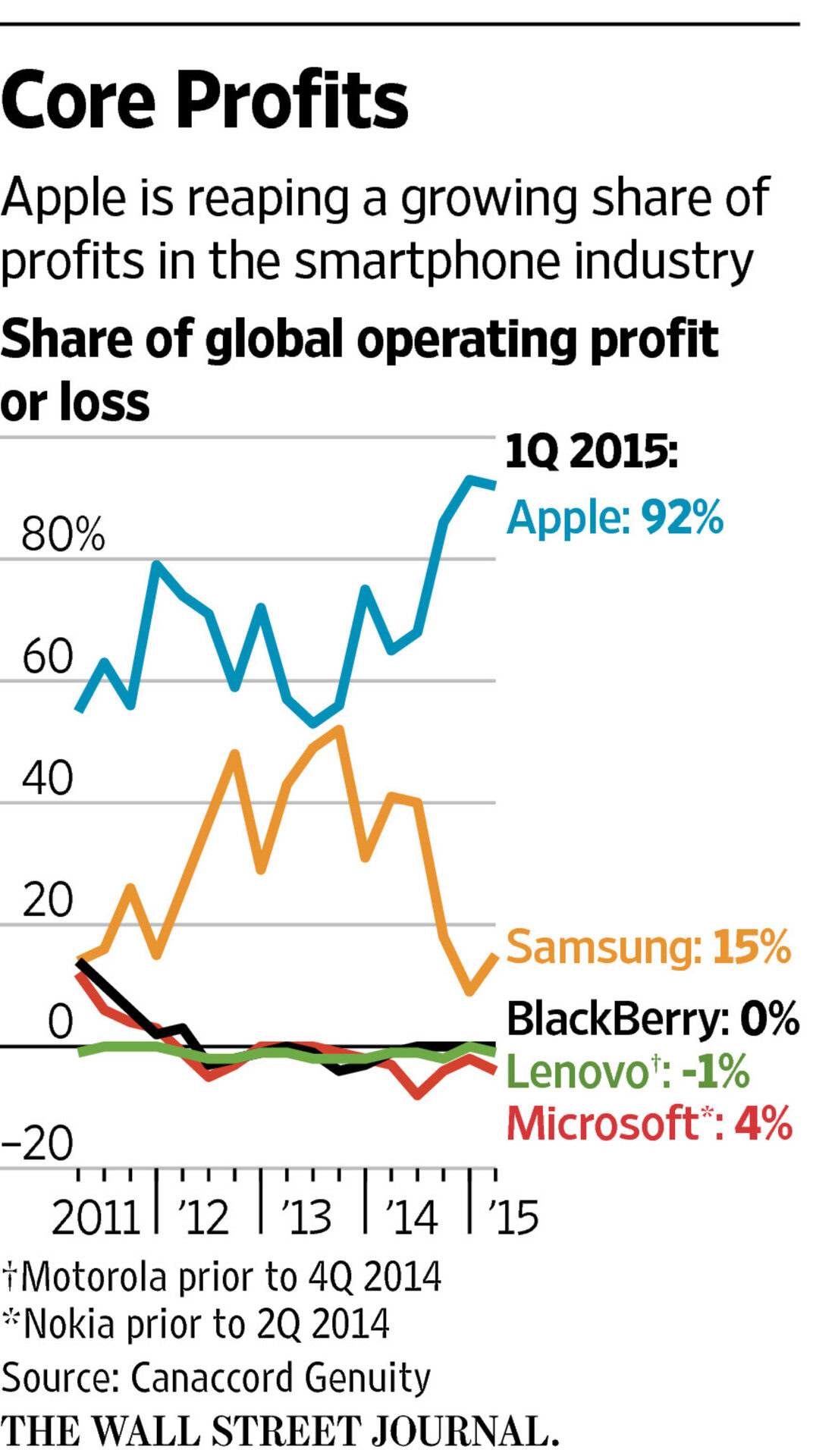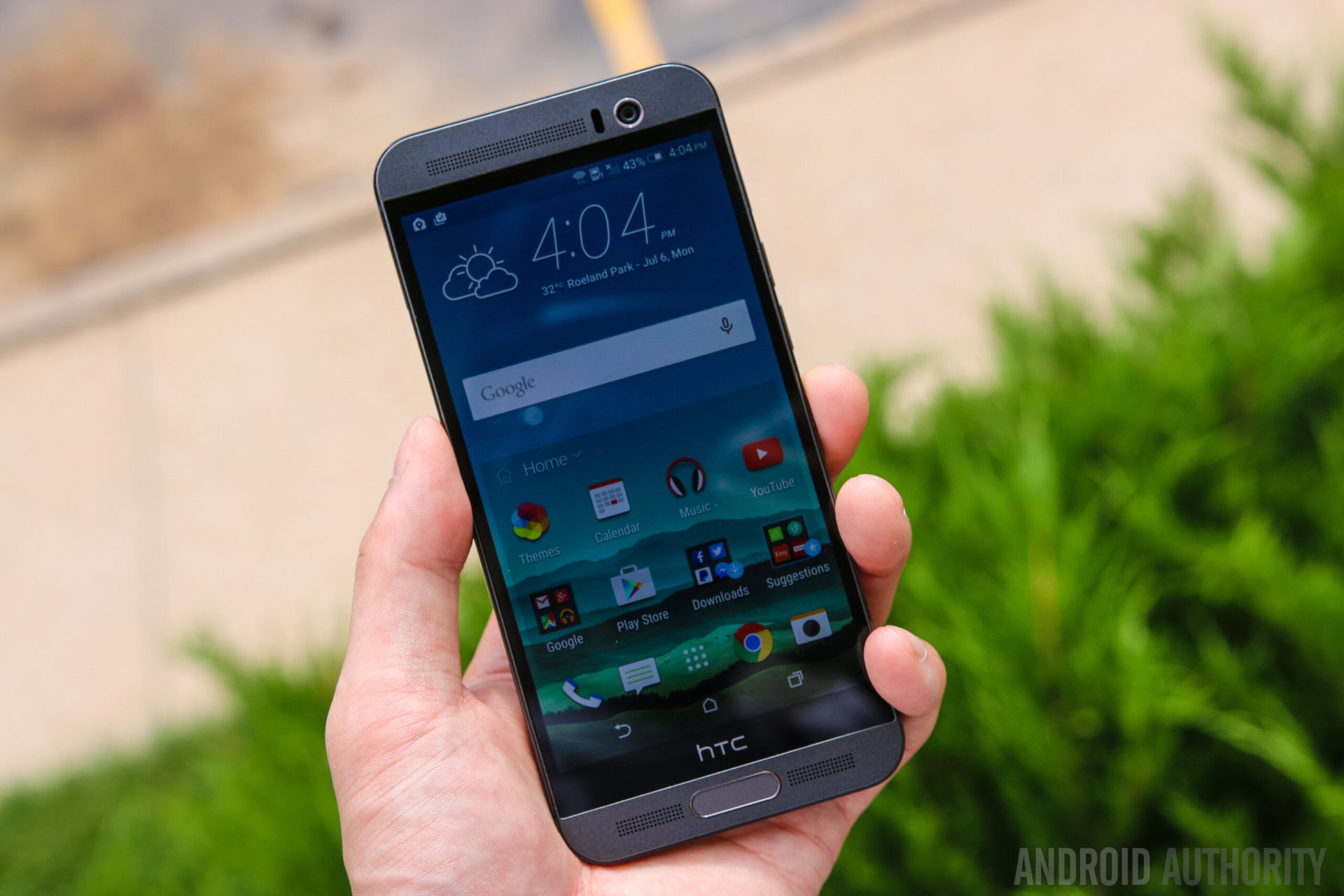Affiliate links on Android Authority may earn us a commission. Learn more.
WSJ: Apple had 92% of smartphone industry's profits in Q1 2015

According to The Wall Street Journal, there are now approximately a thousand different companies producing smartphones. That number is absolutely staggering, and should without a doubt infer that there are OEMs above and beyond the scope of knowledge of just about anyone.
But Apple it seems, receives almost all of the profits from the industry according to Mike Walkley, Canaccord Genuity managing director. Specifically, in the first quarter of 2015, it earned 92% of the total operating income from the world’s leading 8 OEMs, an impressive 65% increase over the same period last year. Samsung, on the other hand, received only 15%. (Because many companies actually lose money in the smartphone business, the total share of those who profit is bigger than 100%.) In light of all those other manufactures who aren’t mentioned, Canaccord estimates that they are essentially irrelevant (from this perspective) given that they “broke even or lost money.”
Apple’s market
The report explains that Apple “sells less than 20% of smartphones, in terms of unit sales” and that “the disparity reflects its ability to command much higher prices for its phones”, something that is no longer true of Android OEMs as they face an increasingly crowded marketplace. The result is a lack of core differentiation which has forced many companies to slash prices in order to appeal to consumers. This trend is totally alien from Apple’s attention, as last year the iPhone “sold for a global average of $624, compared with $185 for smartphones running Android, according to Strategy Analytics.”

It should be note that Canaccord’s data “doesn’t include privately held companies including Xiaomi and India’s Micromax Informatics Ltd.” however, “Mr. Walkley said those companies’ profits—if any—are unlikely to alter the industry-wide profit picture.” While some might be eager to speak otherwise, given the extremely low retail prices for these OEM’s products, it is basically assumed they are selling them at-or-around production costs, and thus what little profit to be had comes from selling massive numbers of product, or even from value-added services, offers, or accessories.
Google’s gain (as OEMs feel the pain)
While this report may enrage Android fans, especially those with more antagonistic views of Apple, this is little more than a reinforcement of just how profitable Cupertino’s business model is, and exactly why companies like Samsung are so eager to try and break free of Android. Indeed there is a certain element of irony at play here: many view Google’s “open” OS as pro-choice, yet Google’s overall business strategy is largely self serving. In other words, Google makes a lot of money of Android, even if actual most phone makers don’t.
It matters very little who makes Android phones, as long as the phones being made are running Google Play Services
Google wants Android on as many devices as possible, because each one is a potential profit center for the company’s main business: advertising. To Google, it matters very little who makes their phones, as long as the phones being made are running Google Play Services. This fractured reality is exactly why the “China situation” is such a pain in Mountain View’s side, and why it’s looking more likely 2015 will see the release of a HUAWEI Nexus.

Indeed as Android has gradually matured, Google has sought to exercise tighter control over the OS. Likewise, the once-flourishing sales of Samsung are ultimately of little concern now that Android has achieved its absolute market share dominance. Whereas the Galaxy series was once – arguably – the sole contender against Apple’s iPhone, the tables have turned and now any random would-be OEM can make a pretty decent smartphone.
Each Android phone is a potential profit center for Google's main business: advertising.
Notice, however, just how rare it is to find any given one (or tablet for that matter) that doesn’t run Google Play Services, something that used to happen on a somewhat frequent basis in the early days of Android and budget-friendly products. This is not to say they don’t exist, not at all, but rather there are just so many smaller-scale tablets that do support Play Services, the problem is nowhere near as pressing as it might once have been.
Profit pictures

As far as key Android OEMs go and their potential for profits, the sad reality is that things don’t look good at all. Samsung had an extremely favorable reception when the Galaxy S6 was announced which prompted almost unreasonable projections of potential sales. Reports began to come in that painted a different picture, and in the more recent past it’s become quite clear that the Korean smartphone manufacturer will ultimately fail to live up to the lofty expectations many had set up. HTC is in a similar boat, largely due to its decision to release the One M9 as its flagship, despite an absolute menagerie of other prime products exclusively available in Asia. LG is also facing scrutiny given that the G4 has, by all accounts so far, failed to live up to its sales potential.
Meanwhile, over in Apple-land, rumblings of rumors couldn’t be more rosy. The WSJ points out that “events last week highlighted the lopsided financial picture [with] Apple…asking suppliers to make a record number of new iPhone models.” Given that the products expected to launch this year, the iPhone 6S and iPhone 6S Plus are – based on past releases – going to retain the same design but instead offer upgraded internals, it truly just shows how much power Apple has when it comes to products, purchases, and profits.
Unlike Apple, HTCor Sony can't get away with releasing iterative products.
HTC by all accounts, did the exact same thing with its One M9 and yet has met with disastrous results. Even Sony has faced intense scrutiny for this strategy given that the Xperia Z4 is basically a retread of the Z3, a reality that has literally forced the company to re-brand it as the Z3+ outside of Japan. How the tables might have turned had HTCat least had the foresight to release the One M9+ as its flagship, or had Sony deemed it fit to launch the Verizon-exclusive Z4v on a global scale.
Forecasting the future

It is unlikely that things will improve for legacy Android OEMs in the future. New rumors are suggesting that Samsung will launch its upcoming Galaxy Note 5 earlier than in the past, simply because it doesn’t want to compete with the iPhone’s juggernaut-strong offensive. Likewise, the company is expected to bring to market a super-sized Galaxy S6 Edge as clear competition for the new iPhone. The Note series has always been a less mainstream affair, and thus it is unlikely to move massive numbers enough to bring Samsung back to positive growth on a mass-scale, the likes of which it used to enjoy on a quarterly basis for year-upon-year in the past.
With even Android’s largest OEM facing slowing sales, the potential for smaller players is all the more marred, baring a major upturning of strategy. In their place will be dozens of companies from China, such as HUAWEI, Xiaomi, ZTE, who will be the ones to truly take advantage of the world’s emerging markets. These companies are not hell-bent on mass profits, nor do many of them have speculators or investors governing the decisions that go on behind the scenes the way that publicly traded companies do.